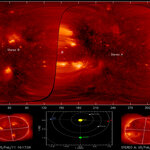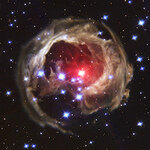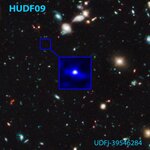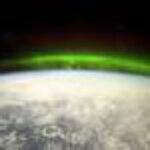Space
Super-massive black holes in the universe vary in mass from about one million to 10 billion times the size of our sun, and they're continuing to grow. Now
astronomers from Tel Aviv University say that the era of the "first fast growth" of these phenomena occurred a mere 1.2 billion years ago — only about half of what was previously believed — and that they
continue to grow at a very fast rate.The new research from Prof. Hagai Hetzer and his student Benny Trakhtenbrot of Tel Aviv University is based on observations from some of the largest
ground-based telescopes in the world: "Gemini North"…

Since Valentine's Day is approaching, it's a good time to combine X-rays from the NASA's Chandra X-ray Observatory (pink) and optical data from the Hubble Space Telescope (red, green, blue) produced by the Space Telescope Science Institute (STScI) into a new image of a ring - not of jewels - but of black holes. The composite image is of Arp 147, a pair of interacting galaxies located about 430 million light years from Earth.
Arp 147 contains the remnant of a spiral galaxy (right) that collided with the elliptical galaxy on the left. This collision has produced an expanding wave of star…

Two STEREO spacecraft are now 180 degrees apart from each other and providing scientists with a 360-degree view of the Sun. NASA's STEREO (Solar Terrestrial Relations Observatory) spacecraft were launched on October 25, 2006, and have been gathering images of solar activity, especially solar storms, since the mission began.
A key component of the STEREO mission is Naval Research Laboratory's Sun Earth Connection Coronal and Heliospheric Investigation (SECCHI), a suite of five scientific telescopes that observe the solar corona and inner heliosphere from the surface of the Sun to the orbit of…

Cosmic Embryo #3: The ART of 3D Sun and Breast Cancer Imaging
NASA Releasing First Views of the Entire
Sun on Super Sun-Day [February 6, 2011]
http://www.nasa.gov/home/hqnews/2011/feb/HQ_M11-025_STEREO.html
http://stereo.gsfc.nasa.gov/
One always does science as a member of a community, one that extends back to our predecessors on whose work we build, horizontally to our contemporaries, and into the future for those who will in turn build on or disassemble what we have constructed in our understanding of this universe. I had the unusual honor recently of being asked to write an…

New papers in arXiv show that the Kepler space telescope continues to fulfill its mission of searching for exoplanets, especially those in the 'habitable' zone, a region where liquid water could exist on a planet's surface, around stars.
Kepler uses the transit method (unsure how astronomers find planets? Read Planet Hunters - How They Do It) because transits by terrestrial planets produce a small change in a star's brightness of about 1/10,000 (100 parts per million, ppm) lasting for 1 to 16 hours. The change must be periodic if it is caused by a planet and all transits…

Astronomers at the Hubble Space Telescope believe they have found the most distant object ever seen in the universe, 13.2 billion light years away, some 3% of the age of universe, making it roughly 150 million light years more distant than the previous record holder, says the report in Nature.
This newly found object, named UDFj-39546284, is a compact galaxy made of blue stars that existed only 480 million years after the Big Bang - and it's tiny. Over one hundred such mini galaxies would be needed to make up our Milky Way.Previous searches had found 47 galaxies at somewhat later…

This morning, as I walked out of home headed to work, the sky was clear and still dark. As I looked up, I immediately noticed the bright light of Venus above the houses of Venice. Have you ever watched Venus on a clear morning sky ? It is a marvelous sight! No wonder the planet was named after the most beautiful of all goddesses.
My trip to the University, in Padova, begins with a 7-minute walk to the Venice train station, followed by a 40 minute ride and then a further 15-minute walk in Padova to reach the Physics Department. While on the train I usually busy myself with document editing on…

In a recent paper, by blah and blah, we have been asked to vote for an official definition of a galaxy. That's easy, I hear you cry: you proceed to draw me an S shaped squiggle on a piece of paper, or even a few fuzzy blobs - not all galaxies are spirals of course.
Or perhaps I underestimate you - maybe you'd answer as I did; that a galaxy is purely a collection of stars, gravitationally bound to eachother. Or perhaps you'd suggest some more complicated; a scientific properti
The thing is - one thing I'm sure we could agree on is the definition; "I know a galaxy when I see one" - or do…

Over at the Journal of Cosmology, an engaging open journal I've discussed before, there is a controversy over their book, "The Human Mission to Mars: Colonizing the Red Planet". Namely, Eurekalert refused to accept their press release. Says the JoC:
EurekAlert has refused to issue a paid-for press release announcing the publication of the book edition of The Human Mission to Mars. Over 120 top scientists, including 4 astronauts who walked on the Moon, co-authored this text.
Loving a good controversy, I eagerly awaited more details. Sure enough, version 2 of JoC's take on…

Back when I was prepping for the ham radio test, I didn't think my skills would be needed so soon. The 'missing' NanoSat-D solar sail mission has appeared, but it can only be heard via radio at 437.275MHz. So they need amateurs to listen and report when they heard it, quickly:
The FM amateur radio downlink on 437.275 MHz is the only source of spacecraft status, and more listeners are needed. The sail is set to deploy after 3 days. The battery may last a little beyond that. We need telemetry collected from all over the world.
Details on how to help at WDFD, urgent. You can…